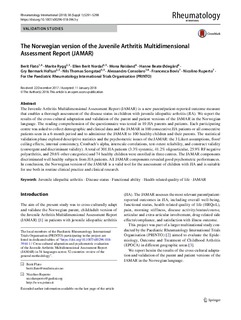| dc.contributor.author | Flatø, Berit | |
| dc.contributor.author | Rygg, Marite | |
| dc.contributor.author | Nordal, Ellen Berit | |
| dc.contributor.author | Røisland, Mona | |
| dc.contributor.author | Ødegård, Hanne Beate | |
| dc.contributor.author | Hoftun, Gry Børmark | |
| dc.contributor.author | Songstad, Nils Thomas | |
| dc.contributor.author | Consolaro, Alessandro | |
| dc.contributor.author | Bovis, Francesca | |
| dc.contributor.author | Ruperto, Nicolino | |
| dc.date.accessioned | 2019-01-09T14:14:13Z | |
| dc.date.available | 2019-01-09T14:14:13Z | |
| dc.date.created | 2018-06-21T15:17:12Z | |
| dc.date.issued | 2018 | |
| dc.identifier.citation | Rheumatology International. 2018, 38 291-298. | nb_NO |
| dc.identifier.issn | 0172-8172 | |
| dc.identifier.uri | http://hdl.handle.net/11250/2580031 | |
| dc.description.abstract | The Juvenile Arthritis Multidimensional Assessment Report (JAMAR) is a new parent/patient-reported outcome measure that enables a thorough assessment of the disease status in children with juvenile idiopathic arthritis (JIA). We report the results of the cross-cultural adaptation and validation of the parent and patient versions of the JAMAR in the Norwegian language. The reading comprehension of the questionnaire was tested in 10 JIA parents and patients. Each participating centre was asked to collect demographic and clinical data and the JAMAR in 100 consecutive JIA patients or all consecutive patients seen in a 6-month period and to administer the JAMAR to 100 healthy children and their parents. The statistical validation phase explored descriptive statistics and the psychometric issues of the JAMAR: the 3 Likert assumptions, floor/ceiling effects, internal consistency, Cronbach’s alpha, interscale correlations, test–retest reliability, and construct validity (convergent and discriminant validity). A total of 301 JIA patients (3.3% systemic, 41.2% oligoarticular, 25.9% RF negative polyarthritis, and 29.6% other categories) and 74 healthy children were enrolled in three centres. The JAMAR components discriminated well healthy subjects from JIA patients. All JAMAR components revealed good psychometric performances. In conclusion, the Norwegian version of the JAMAR is a valid tool for the assessment of children with JIA and is suitable for use both in routine clinical practice and clinical research. | nb_NO |
| dc.language.iso | eng | nb_NO |
| dc.publisher | Springer Verlag | nb_NO |
| dc.rights | Navngivelse 4.0 Internasjonal | * |
| dc.rights.uri | http://creativecommons.org/licenses/by/4.0/deed.no | * |
| dc.title | The Norwegian version of the Juvenile Arthritis Multidimensional Assessment Report (JAMAR) | nb_NO |
| dc.type | Journal article | nb_NO |
| dc.type | Peer reviewed | nb_NO |
| dc.description.version | publishedVersion | nb_NO |
| dc.source.pagenumber | 291-298 | nb_NO |
| dc.source.volume | 38 | nb_NO |
| dc.source.journal | Rheumatology International | nb_NO |
| dc.identifier.doi | 10.1007/s00296-018-3963-y | |
| dc.identifier.cristin | 1592995 | |
| dc.description.localcode | © The Author(s) 2018 Open Access. This article is distributed under the terms of the Creative Commons Attribution 4.0 International License (http://creativecommons.org/licenses/by/4.0/) | nb_NO |
| cristin.unitcode | 194,65,15,0 | |
| cristin.unitname | Institutt for klinisk og molekylær medisin | |
| cristin.ispublished | true | |
| cristin.fulltext | original | |
| cristin.qualitycode | 1 | |

